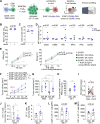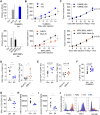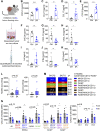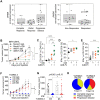Activin-A impairs CD8 T cell-mediated immunity and immune checkpoint therapy response in melanoma
- PMID: 35580932
- PMCID: PMC9125758
- DOI: 10.1136/jitc-2022-004533
Activin-A impairs CD8 T cell-mediated immunity and immune checkpoint therapy response in melanoma
Abstract
Background: Activin-A, a transforming growth factor β family member, is secreted by many cancer types and is often associated with poor disease prognosis. Previous studies have shown that Activin-A expression can promote cancer progression and reduce the intratumoral frequency of cytotoxic T cells. However, the underlying mechanisms and the significance of Activin-A expression for cancer therapies are unclear.
Methods: We analyzed the expression of the Activin-A encoding gene INHBA in melanoma patients and the influence of its gain- or loss-of-function on the immune infiltration and growth of BRAF-driven YUMM3.3 and iBIP2 mouse melanoma grafts and in B16 models. Using antibody depletion strategies, we investigated the dependence of Activin-A tumor-promoting effect on different immune cells. Immune-regulatory effects of Activin-A were further characterized in vitro and by an adoptive transfer of T cells. Finally, we assessed INHBA expression in melanoma patients who received immune checkpoint therapy and tested whether it impairs the response in preclinical models.
Results: We show that Activin-A secretion by melanoma cells inhibits adaptive antitumor immunity irrespective of BRAF status by inhibiting CD8+ T cell infiltration indirectly and even independently of CD4 T cells, at least in part by attenuating the production of CXCL9/10 by myeloid cells. In addition, we show that Activin-A/INHBA expression correlates with anti-PD1 therapy resistance in melanoma patients and impairs the response to dual anti-cytotoxic T-Lymphocyte associated protein 4/anti-PD1 treatment in preclinical models.
Conclusions: Our findings suggest that strategies interfering with Activin-A induced immune-regulation offer new therapeutic opportunities to overcome CD8 T cell exclusion and immunotherapy resistance.
Keywords: immune evasion; immunotherapy; melanoma; tumor microenvironment.
© Author(s) (or their employer(s)) 2022. Re-use permitted under CC BY. Published by BMJ.
Conflict of interest statement
Competing interests: None declared.
Figures






References
MeSH terms
Substances
LinkOut - more resources
Full Text Sources
Other Literature Sources
Medical
Research Materials
